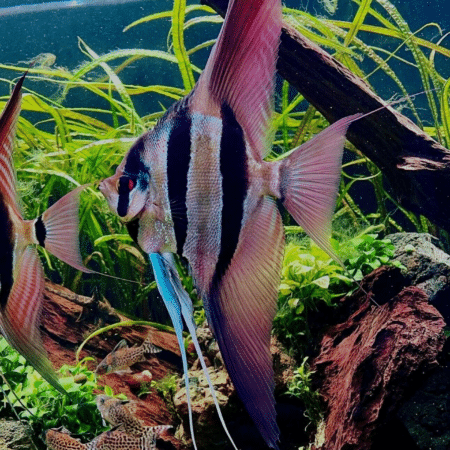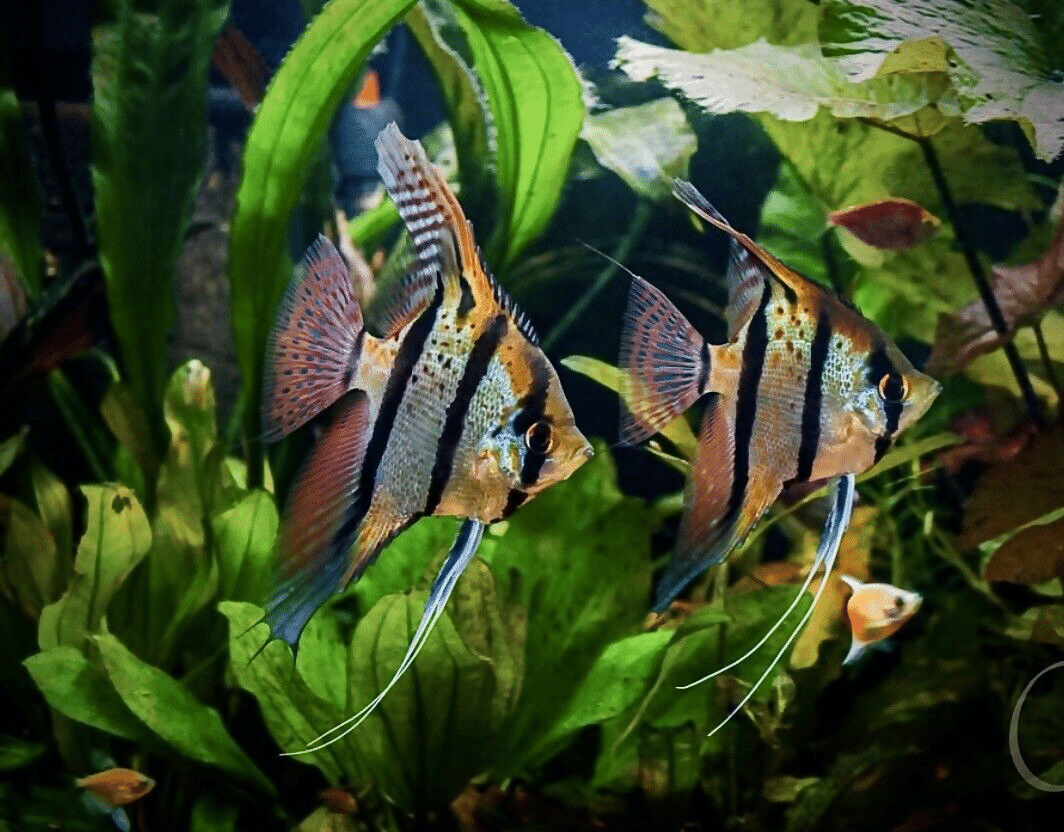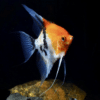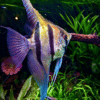Subtotal: £34.84
Rio Nanay Angelfish Pterophyllum Scalare South American Cichlid, Thriving Fish That Enhances Any Aquarium, Peaceful Community Members for Planted Tank Environments, Stunning Visual Appeal
£29.49 Original price was: £29.49.£24.99Current price is: £24.99.
Welcome these beautiful Rio Nanay Angelfish, a striking South American Cichlid, to your aquarium. With their vibrant colors and graceful movements, they thrive in planted tanks. Perfect for aquarists seeking elegant community members for peaceful environments. Care for them today!
1993 in stock
Species Introduction
The Rio Nanay Angelfish, scientifically known as Pterophyllum scalare, is a stunning species of freshwater fish that hails from the Amazon Basin in South America. This beautiful cichlid is not only known for its graceful swimming patterns but also for its striking appearance, characterized by elongated fins and a variety of color morphs including silver, black, and gold. These fish thrive in slow-moving waters, often found among submerged vegetation and in the shadows of riverbanks. The Rio Nanay Angelfish is a peaceful community member, making it an excellent choice for planted tank environments where it can exhibit its natural behaviors and contribute to the overall aesthetic of the aquarium.
Care Requirements Dashboard
Essential Care Guide for Your Rio Nanay Angelfish
| Optimal Living Conditions | |
|---|---|
| Water Temperature | 24-27°C (75-81°F) |
| pH Level | 6.5-7.5 |
| Water Hardness | 4-12 dKH |
| Minimum Tank Size | 80L (20 gal) |
| Salinity | Freshwater |
| Care Level | Beginner Friendly |
✓ Care Level: Easy
Natural Behavior & Temperament
Rio Nanay Angelfish are known for their calm and gentle demeanor, making them ideal for peaceful community tanks. They exhibit a unique swimming pattern, often gliding gracefully through the water column and occasionally hovering near the substrate. These fish are social creatures that thrive in groups, and they often establish hierarchies within their schools. It is essential to provide ample hiding spots and territories within the aquarium to reduce stress and aggression. When kept in a well-planted tank, they will display natural behaviors such as foraging and exploring, which enhances their well-being and contributes to a vibrant aquarium environment.
Tank Setup Guide
Creating an ideal environment for your Rio Nanay Angelfish involves replicating their natural habitat as closely as possible. Begin with a minimum tank size of 20 gallons, ensuring that the water is well-filtered and maintained at the appropriate temperature and pH levels. Use a soft substrate such as fine gravel or sand to mimic the riverbed of their natural habitat. Incorporate plenty of aquatic plants, driftwood, and rocks to provide hiding spots and territories. Floating plants can also help diffuse light and create a more natural setting. Ensure that the tank has adequate water movement to simulate their natural environment, but avoid strong currents that may stress the fish.
Water Quality Management
Maintaining optimal water quality is crucial for the health and well-being of your Rio Nanay Angelfish. Regular water testing is recommended to monitor pH, temperature, and hardness levels. The ideal pH range for these fish is between 6.0 and 7.5, with a temperature of 76-82°F (24-28°C). Water hardness should be maintained between 3-10 dGH. Perform regular water changes of 20-30% weekly to ensure the removal of waste and toxins. Additionally, consider using a high-quality water conditioner to remove harmful chemicals and chlorine from tap water before adding it to the tank. Keeping the aquarium clean and well-maintained will help prevent diseases and promote a healthy environment for your aquatic companions.
Feeding & Nutrition
Rio Nanay Angelfish are omnivorous and thrive on a varied diet that includes high-quality flake foods, pellets, and frozen or live foods such as brine shrimp and bloodworms. A balanced diet is essential for their growth, coloration, and overall health. Feed them small amounts 2-3 times a day, ensuring that all food is consumed within a few minutes to prevent water quality issues. It is also beneficial to incorporate vegetable matter into their diet, such as spirulina flakes or blanched vegetables, to provide essential nutrients. Regularly varying their diet will help keep them healthy and vibrant.
Compatibility Guide
✓ Peaceful Community Fish
When considering tank mates for your Rio Nanay Angelfish, it is important to choose peaceful species that will not provoke aggression. Suitable tank mates include tetras, rasboras, and other small cichlids. Avoid aggressive or territorial fish, as they can stress your angelfish and lead to health issues. Additionally, be cautious with smaller fish that may be seen as food. A well-balanced community tank will enhance the social dynamics of your aquarium and provide a harmonious environment for all inhabitants.
Health & Wellness
Regular monitoring of your Rio Nanay Angelfish is essential to ensure their health and well-being. Common health issues include ich, fin rot, and swim bladder disorders. Signs of illness may include changes in behavior, loss of appetite, or visible lesions. To prevent health issues, maintain excellent water quality, provide a balanced diet, and reduce stress by avoiding overcrowding and aggressive tank mates. If health problems arise, prompt treatment is crucial. Quarantine new fish before introducing them to your main tank to prevent the spread of disease.
Breeding Information
Breeding Rio Nanay Angelfish can be a rewarding experience for aquarists. These fish are known to form monogamous pairs, and breeding typically occurs in a well-maintained tank with optimal water conditions. To encourage breeding, provide flat surfaces for spawning, such as slate or broad-leaved plants. The female will lay eggs, which the male will fertilize. After spawning, both parents will guard the eggs until they hatch, usually within 24-48 hours. Once the fry are free-swimming, they can be fed infusoria or finely crushed flakes. It is important to provide ample hiding spots for the fry to avoid predation from adult fish.
Acclimation Process
Introducing your Rio Nanay Angelfish to a new aquarium requires a careful acclimation process to minimize stress and ensure a smooth transition. Begin by floating the sealed bag containing the fish in the aquarium for about 15-20 minutes to equalize the temperature. After that, gradually introduce small amounts of tank water into the bag every 5-10 minutes for about an hour. This process helps the fish adjust to the water chemistry of their new home. Once acclimated, gently release the fish into the tank using a net to avoid adding excess water from the bag. Monitor their behavior closely for the first few days to ensure they are adjusting well.
Long-term Care
Rio Nanay Angelfish can live for several years with proper care, often reaching an age of 10 years or more in a well-maintained aquarium. As they grow, they may require a larger tank to accommodate their size and social behavior. Regularly assess the tank environment and make adjustments as necessary to maintain optimal conditions. Keep an eye on their growth and health, and be prepared to provide additional space or modify their diet as they mature. Engaging with your fish friends daily will also enhance their well-being and foster a strong bond between you and your aquatic companions.
Natural Habitat Recreation
To create a biotope that reflects the natural habitat of Rio Nanay Angelfish, focus on replicating the lush, plant-filled waters of the Amazon. Use a variety of live plants, such as Amazon swords, Java ferns, and floating plants, to create a dense environment that mimics their natural surroundings. Incorporate driftwood and rocks to provide hiding spots and territorial boundaries. The use of natural materials will not only enhance the aesthetic appeal of the aquarium but also contribute to the overall health and happiness of your fish. Regularly maintain the plants and decorations to ensure they remain healthy and provide a suitable environment for your angelfish.
Seasonal Care Adjustments
As seasons change, so do the needs of your Rio Nanay Angelfish. During warmer months, monitor the water temperature closely to prevent overheating, as angelfish prefer stable conditions. In colder months, consider using a heater to maintain the optimal temperature range. Additionally, adjust the lighting duration to simulate natural day/night cycles, which can influence breeding behaviors and overall health. Regularly check water parameters and perform maintenance as needed to ensure a stable environment throughout the year. Being proactive in seasonal care will help your fish thrive and maintain their vibrant colors.
Expert Tips
To ensure the best care for your Rio Nanay Angelfish, consider the following expert tips: First, always quarantine new fish before introducing them to your main tank to prevent the spread of disease. Second, maintain a consistent feeding schedule and vary their diet to promote health and vitality. Third, regularly monitor water quality and perform partial water changes to keep the environment clean. Lastly, engage with your fish regularly to help them feel comfortable and secure in their surroundings. By implementing these practices, you will foster a thriving community tank that showcases the beauty and grace of these magnificent fish.
Troubleshooting
If you encounter issues with your Rio Nanay Angelfish, it is important to address them promptly. Common problems include stress from aggressive tank mates, poor water quality, or inadequate diet. If your fish are displaying signs of stress, such as hiding or refusing to eat, assess the tank environment and make necessary adjustments. Ensure that water parameters are within the recommended ranges and that tank mates are compatible. If health issues arise, consult with a knowledgeable aquarist or veterinarian for guidance on treatment options. Being proactive in troubleshooting will help ensure the long-term health and happiness of your aquatic companions.
Scientific Background
The Rio Nanay Angelfish, or Pterophyllum scalare, belongs to the family Cichlidae, which encompasses a diverse range of freshwater fish known for their complex behaviors and vibrant colors. This species is native to the Amazon River basin, where it inhabits slow-moving waters rich in vegetation. The angelfish is often studied for its interesting social structures and breeding behaviors, making it a popular choice among aquarists and researchers alike. Conservation efforts are in place to protect their natural habitat, as deforestation and pollution pose threats to their populations. Understanding the scientific background of this species can enhance your appreciation for these beautiful fish and their ecological significance.
Advanced Care Techniques
For experienced aquarists looking to elevate their care for Rio Nanay Angelfish, consider implementing advanced techniques such as breeding programs or specialized feeding regimens. Creating a breeding setup with optimal conditions can lead to successful spawning and fry rearing. Additionally, experimenting with different food types, including live and frozen options, can enhance coloration and vitality. Regularly documenting your observations and adjustments can provide valuable insights into their behavior and health. Engaging in continuous learning and adaptation will not only benefit your fish friends but also enrich your experience as an aquarist.
Water Quality Parameters
Optimal Range
24-27°C
6.5-7.5
0 ppm
Caution Zone
22-24°C or 27-29°C
6.0-6.5 or 7.5-8.0
0.25-0.5 ppm
Danger Zone
<22°C or >29°C
<6.0 or >8.0
>0.5 ppm
Monitoring Tip: Test water parameters weekly and perform regular water changes to maintain optimal conditions for your aquatic friends!
Frequently Asked Questions
Q: What tank size is required for Rio Nanay Angelfish?
Rio Nanay Angelfish thrive in an aquarium of at least 200 litres, as they require ample swimming space and territory. A larger tank not only accommodates their growth but also helps maintain stable water parameters, which is crucial for their health. It is advisable to have a tall tank, as angelfish prefer vertical space due to their natural behaviour of swimming upwards. Additionally, the tank should be well-planted with hiding spots to mimic their natural habitat, providing security and reducing stress levels. In a smaller tank, they may become territorial, leading to stress and aggression among tank mates.
✓ Expert Tip
Consider a tank with a minimum height of 60 cm to allow for their natural swimming behaviour.
Q: What water parameters do Rio Nanay Angelfish require?
Rio Nanay Angelfish prefer slightly acidic to neutral water conditions, ideally with a pH between 6.5 and 7.5. The water temperature should be maintained between 24-28°C, with stable conditions being critical to their health. Regular water changes of about 25% weekly are recommended to keep nitrate levels low and ensure optimal water quality. It is also essential to utilise a good filtration system to maintain clear and clean water. Test kits for pH, ammonia, nitrites, and nitrates should be used regularly to monitor water parameters effectively.
✓ Expert Tip
Introduce driftwood and plants to help buffer pH levels naturally, mimicking their natural habitat.
Q: How often should I feed Rio Nanay Angelfish?
Rio Nanay Angelfish should be fed 2-3 times a day, with portions they can consume within a few minutes. A varied diet is essential for their health, including high-quality flakes, pellets, and occasional live or frozen foods such as bloodworms and brine shrimp. This diversity not only enhances their nutritional intake but also promotes vibrant colours and healthy growth. Be cautious not to overfeed, as this can lead to water quality issues and health problems. Regular feeding times can help establish a routine, making it easier for aquarium keepers to monitor their fish’s appetite.
✓ Expert Tip
Consider using a feeding ring to prevent food from floating away, ensuring all fish have access.
Q: What are the best tank mates for Rio Nanay Angelfish?
When selecting tank mates for Rio Nanay Angelfish, opt for peaceful community species that share similar water parameter requirements. Suitable companions include tetras, rasboras, and other non-aggressive cichlids. Avoid smaller fish that may be seen as prey, as angelfish can exhibit predatory behaviour. Additionally, consider fish that prefer the middle to upper levels of the tank, allowing for harmonious swimming patterns. Introducing tank mates gradually and monitoring interactions will help ensure a peaceful community. Each fish has its personality, so observe them closely for any signs of aggression.
✓ Expert Tip
Adding plants and decorations can help create territories and reduce aggression.
Q: How do I properly acclimatise Rio Nanay Angelfish to my aquarium?
Acclimatising Rio Nanay Angelfish is crucial to ensure their health and reduce stress. Begin by floating the sealed bag in the aquarium for about 15-20 minutes to equalise the temperature. After this, gradually introduce small amounts of tank water into the bag every 5-10 minutes for about an hour. This process helps them adjust to the water parameters of their new environment. Once acclimatised, gently release the fish into the tank without adding the bag water. This method allows for a smooth transition and minimises shock, promoting a healthy start in their new home.
✓ Expert Tip
Ensure the tank is fully cycled before introducing new fish to ensure optimal water quality.
Q: What are the signs of healthy Rio Nanay Angelfish?
Healthy Rio Nanay Angelfish should exhibit bright colours, clear eyes, and active swimming patterns. They should be responsive to their surroundings and show interest in food during feeding times. Additionally, observe for any signs of distress, such as clamped fins, unusual swimming behaviour, or loss of appetite, which could indicate health issues. Regular monitoring of their behaviour and physical appearance will help detect any potential problems early. Keeping their environment clean and maintaining stable water parameters are essential for their overall well-being.
✓ Expert Tip
Regularly check for signs of disease, such as white spots or lesions, and act promptly if noticed.
Q: How do I successfully breed Rio Nanay Angelfish?
Breeding Rio Nanay Angelfish can be a rewarding endeavour. To encourage breeding, maintain a stable environment with optimal water parameters and provide flat surfaces for spawning, such as broad leaves or breeding cones. A pair of angelfish will often form a bond, and once they are ready to spawn, they will lay eggs on the chosen surface. Ensure that the breeding pair is well-fed with a nutritious diet. After spawning, it is common for the parents to guard the eggs, which typically hatch in 48-72 hours. It’s advisable to separate the parents from the fry after hatching to prevent them from eating their young.
✓ Expert Tip
Use a separate breeding tank to increase the survival rate of the fry.
Q: What temperature should I maintain for Rio Nanay Angelfish?
The ideal temperature range for Rio Nanay Angelfish is between 24-28°C. Maintaining this temperature range is essential for their metabolic processes and overall health. Sudden fluctuations in temperature can cause stress and make them more susceptible to diseases. It is advisable to use an aquarium heater with a reliable thermostat to ensure consistent temperatures. Regularly monitor the temperature using an accurate thermometer. In addition, it is wise to place the heater near a good water circulation area to evenly distribute heat throughout the tank.
✓ Expert Tip
Consider using a backup heater in case of power failures to prevent sudden temperature drops.
Q: What type of substrate is most suitable for Rio Nanay Angelfish?
For Rio Nanay Angelfish, a fine, soft substrate is recommended to protect their delicate fins and encourage natural behaviours such as digging and foraging. Options such as sand or fine gravel can create a comfortable environment. Additionally, using a darker substrate can enhance the colours of the fish, making them more visually striking. It is essential to avoid sharp-edged substrates that could injure the fish. Regular vacuuming is also necessary to maintain cleanliness and prevent detritus buildup, which can lead to poor water quality.
✓ Expert Tip
Consider layering the substrate with nutrient-rich soil beneath the top layer for planted tanks.
Q: What behavioural patterns should I expect from Rio Nanay Angelfish?
Rio Nanay Angelfish are known for their elegant swimming style and social behaviour. They tend to establish territories, especially during breeding, and may exhibit some aggression towards tank mates that invade their space. Generally, they are peaceful and can coexist with other calm species. They enjoy exploring their environment, so providing plenty of plants and decorations will encourage natural behaviours. Additionally, angelfish are known to form bonds with their tank mates, showing signs of curiosity and interaction. Observing their behaviour can provide insights into their health and happiness.
✓ Expert Tip
Keep an eye on their social interactions, as stress can manifest in changes in behaviour.
Q: How can I prevent common diseases in Rio Nanay Angelfish?
Preventing diseases in Rio Nanay Angelfish involves maintaining optimal water quality and a stress-free environment. Regular water changes, proper filtration, and monitoring of water parameters are crucial. Quarantining new fish before introducing them to the main tank can prevent the spread of pathogens. Additionally, a balanced diet rich in vitamins and minerals will bolster their immune system. Be vigilant for signs of stress or illness, such as changes in behaviour or physical appearance, and address any issues promptly. Regularly cleaning the tank and decorations will also help eliminate potential disease vectors.
✓ Expert Tip
Consider using aquarium salt in moderation to help prevent certain diseases.
Q: What lighting conditions do Rio Nanay Angelfish prefer?
Rio Nanay Angelfish thrive in moderate lighting conditions that mimic their natural habitat. A lighting setup that provides a gentle illumination is ideal, as overly bright lights can cause stress and encourage algae growth. Using a combination of LED lights with a timer can help establish a consistent day-night cycle, which is beneficial for their behaviour and breeding. Additionally, incorporating live plants can help diffuse the light, creating a more natural environment. Aim for around 10-12 hours of light per day to promote healthy plant growth and the well-being of your angelfish.
✓ Expert Tip
Adjust lighting intensity based on the types of plants in your aquarium to prevent light stress.
Q: How do I recognise stress in Rio Nanay Angelfish?
Recognising stress in Rio Nanay Angelfish is essential for their well-being. Common signs of stress include clamped fins, erratic swimming patterns, hiding excessively, or refusing food. Their colours may also appear dull or faded. Stress can be caused by various factors, including poor water quality, aggressive tank mates, or sudden changes in the environment. It is crucial to monitor their behaviour closely and address any issues promptly. Providing a stable environment, ample hiding spots, and maintaining good water quality will help reduce stress levels and ensure your fish friends remain healthy and vibrant.
✓ Expert Tip
Introduce new fish slowly and monitor interactions to prevent stress-related issues.
Q: What natural habitat conditions should I replicate for Rio Nanay Angelfish?
To replicate the natural habitat of Rio Nanay Angelfish, create a soft, dimly lit environment with plenty of plants and hiding spots. In the wild, they inhabit slow-moving waters with plenty of vegetation, so incorporating live plants such as Java fern or Anubias can provide cover and mimic their natural surroundings. Additionally, using driftwood or rocks can create territories and offer shelter. Maintain a gentle water flow to replicate their natural conditions, and ensure the water parameters are stable and suitable for their needs. This environment will not only reduce stress but also encourage natural behaviours.
✓ Expert Tip
Regularly prune plants to maintain a healthy balance and prevent overcrowding.













Emily Carter (verified owner) –
I recently added the Rio Nanay Angelfish (Pterophyllum Scalare) to my tropical fish setup, and I couldn’t be happier! After a couple of weeks, they have settled in beautifully and display such vibrant colors. Watching them glide through the water is mesmerizing! I chose this species because of their peaceful temperament, and they have adjusted well with my other fish.
I’ve kept angelfish before, but these truly stand out in both beauty and personality. The fins are longer and more graceful compared to some other angelfish I’ve had in the past, and they seem to thrive in a well-planted aquarium setting. I make sure to keep the tank clean and the water parameters stable, which I believe contributes to their happiness.
If you’re a fish enthusiast looking for a stunning and easy-to-care-for addition to your aquarium, I wholeheartedly recommend the Rio Nanay Angelfish. Just be mindful to give them enough space and good water quality, and you’ll enjoy watching them flourish. So far, there’s been no sign of stress, and I plan on buying more soon! This has definitely enhanced my aquarium experience.
Emily Carter (verified owner) –
I recently added the Rio Nanay Angelfish to my planted tank, and I couldn’t be happier! These beautiful cichlids have brought a vibrant splash of color and activity to my aquarium. After about two weeks, I’ve noticed how well they interact with other peaceful community fish; they’re truly gentle giants. I’ve kept various cichlids before, but these angelfish are notably peaceful and thrive in a balanced environment, which is ideal for my setup.
What I particularly appreciate is their adaptability to the planted tank conditions. They gracefully glide among the plants and really enhance the overall aesthetic of my aquarium. Shipping was a breeze, and they arrived in great condition, which is always a concern for me as a caring fish parent.
I did notice, however, that they require a bit more space compared to standard community fish — so if you’re considering them, ensure your tank has ample room for them to swim freely. Overall, I highly recommend the Rio Nanay Angelfish for anyone looking to elevate their aquarium’s beauty while maintaining a peaceful community. They truly have a knack for making an aquarium feel lively and vibrant!